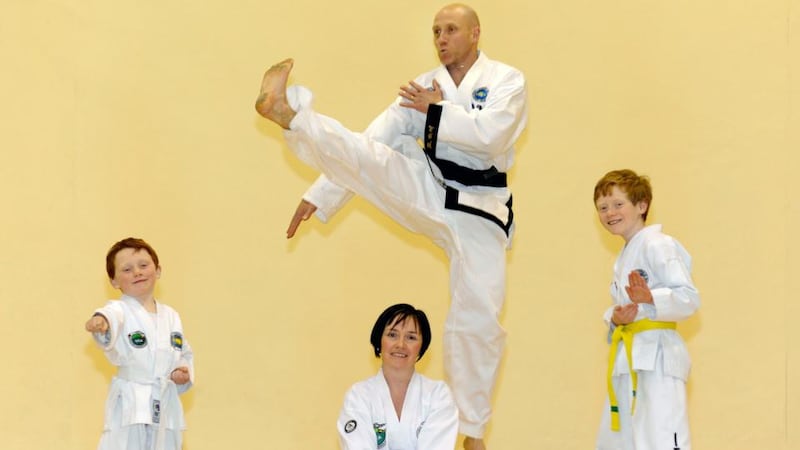Like many parents, mother-of-four June O’Donoghue worries about the possibility of any of her children becoming victims of bullying.
“There is so much of it going on now and in different forms,” she says. “Years ago it was just in the schools; now it is on the internet and everywhere.”
But she has fewer concerns since her two sons, Lee (eight) and Luke (five), started taking classes in the martial art of taekwondo. She sees a new air of confidence in the older boy.

“He wouldn’t be the one who would be picked on now. It gives him that inner strength, that he can stand up for himself. And, God forbid if he was in a situation, he would have a much better idea of how to defend himself.”
Lee goes to classes twice a week and she sees how his physical fitness is being built up, while she believes his memory and concentration are being improved by learning the patterns of movement. Beginners start with a white belt and work up through the colours to a black belt, with “tag” stages in between.
“They are always looking at what the next thing is,” says June. “It’s not like playing football – there is no winning or losing in this, just constant goals to move on to.”
Some people might think that sending children to martial arts classes is giving them a licence to high kick and karate chop their way through the school yard. But that’s the stuff of films and TV, although that’s not to say children aren’t attracted by the on-screen depiction of human fighting machines.
The O’Donoghue boys attend Beaumont Taekwondo Centre in Dublin, where the master, Gerry Martin, regularly sees how children and their parents come for different reasons.
“The parents will send the kids along because maybe they want them to learn self- defence; they want them to have a little discipline; or maybe they feel they are sitting in the house watching TV and they want them out doing physical activity, with people.
“Whereas the kids are not looking for self-defence, or the discipline, or the fitness. They see kids striking the pads or jumping over little obstacles, or playing memory games – they absolutely love that,” says Martin, a seventh degree black belt. But unbeknown to themselves, children soon learn the self-discipline that is an integral part. “They see kids who are there a little longer and see how they do it and they fall into line very, very quickly.”
Martin, who took up taekwondo in 1975 when he was in his teens, says it was Bruce Lee films that attracted him to it.
In reality, most martial arts are primarily about self-defence and avoiding aggression rather than initiating or inviting it, with huge emphasis on self-control and respect. And it is recommended not only for children who may be vulnerable to bullying but also for those inclined to be the perpetrators.
"There is no doubt that any training in martial arts starts to create a safer space around a young person," says Brendan Dowling, president of the Irish Martial Arts Commission. "Just by the fact they are holding their body more confidently, they are less intimidated by acts of aggression – all the signals that make somebody more prone to being targeted for bullying are lessened by all aspects of martial arts."
While it may be counter-intuitive to suggest that a swaggering child should learn punching and kicking skills, martial arts do not create bullies, he stresses.
“There is a huge ethos within martial arts that you don’t use it unless it is the only resort left to you,” says Dowling. “Running away is the first option. We even train for that physically – just giving them ‘permission’ to do that.”
He is an instructor in aikido, which is only about self-defence and being “actively passivist”. At children’s classes in the Royal College of Surgeons off St Stephen’s Green, he advocates “shout, run and tell”– shout your disapproval assertively; run away; and then tell somebody who might have more ability to do something about it.
Martin and his fellow instructors emphasise the five tenets of taekwondo – courtesy, integrity, perseverance, self-control and indomitable spirit.
“They are the foundation of the martial arts,” he says. “Without them it would just be a physical activity, learning how to punch and kick.”
They don’t discuss bullying directly with the children. “We approach it through our tenets. We try to give them different scenarios – this is where you are not showing courtesy, you are not exercising self-control . . . We would ask them if they had come across this type of behaviour.”
He recalls one child who said he was being pushed around by a particular boy in the school yard, coming to class one evening “lit up”. He said this time when the boy moved in on him, “I blocked him and he hasn’t come near me since”.
With heightened concern about cyberbullying, the relevance of physical responses might seem questionable. Some 18 per cent of parents believe their child has been bullied online, according to a survey published last month by the National Association of Principals and Deputy Principals.
But cyberbullying rarely happens in isolation; it is usually simply another channel for something that is going on within a core group at school.
Mona O’Moore, founder and co-ordinator of the Anti-Bullying Centre in Trinity College Dublin, believes martial arts are of value to both victims and perpetrators of bullying.
“From a victim’s perspective – it is dealing with all their issues,” she says. Victims lose confidence, their self-esteem is down, they may find it hard to be assertive and they often have few friends.
“Martial arts offer opportunities that fit multiple factors.” They are learning self-discipline within a fairly structured group, in an environment outside school.
“It allows them to build self-efficacy in how they would deal with what they may perceive as a threatening situation,” O’Moore explains.
Victims often interpret behaviours and gestures in a threatening and negative way. Even if they are still inclined to do that, feeling they now have the skills to handle a situation that might arise will boost their self-esteem.
It will do no harm, either, if word gets around that a child is learning martial arts as it can make other youngsters wary.
O’Moore believes the physicality of the approach is more effective than learning just the theory of assertiveness.
“They can go to workshops and talk it, but here you are doing it, putting words into action. It is body and mind together, which is a far stronger component than sitting in a workshop listening to assertiveness skills.”
She also believes martial arts is “absolutely perfect” for those inclined to be bullies, as are other sports. “Take boxing – people are very critical of boxing whereas I see the benefits of bringing youngsters into a very structured environment where they learn skills sets – they learn self-discipline, they learn self-control.”
A lot of bullies come from homes where there is very poor discipline, a lot of inappropriate aggression and little respect. A child or teenager sometimes uses bullying as a means of developing self-confidence – manipulating relationships to gain status.
“They may have leadership qualities and here is an opportunity to channel them into a more constructive way of behaving,” she says. They can get a sense of success by progressing up the ranks in martial arts and realise “they don’t need to destroy people in order to meet their needs”.
Bullies have lots of insecurities, poor anger management and poor empathy, O’Moore adds. “All of these can be modified when they start gaining success through various legitimate ways.”
June O’Donoghue and her husband Derek needed no convincing of the benefits of taekwondo for their children, as both of them took it up as teenagers themselves at a club in Exchequer Street, since closed, where Martin was teaching at the time. Starting a family made finding time for it more difficult, particularly for June who stopped for many years.
But in 2011, when Martin opened the Beaumont club close to their home in Santry, it was a “no brainer”, she says, for her to start again. As soon as she did, she realised why she loved it so much.
Although she has yet to persuade their daughters, aged 15 and 17, to join them, she thinks it is great for the younger boys to see both their parents taking part, showing it is an activity to continue into adulthood.
Other parents have been inspired to take it up after bringing their children along for a few classes.
“They often say ‘I’d love to try it but am I too old?’ ” says Martin. His response is: “What is the point of you just sitting there?”
And before they know it, they’re dressed in the white robes and high kicking with the best of them, in what is a good physical workout for all ages.
For more information, see: imac.ie; beaumonttaekwondocentre.com; abc.tcd.ie
swayman@irishtimes.com















